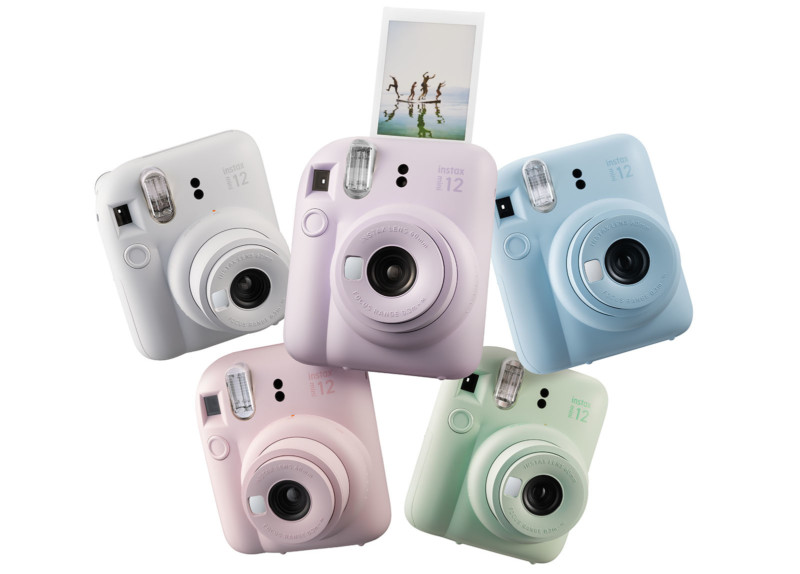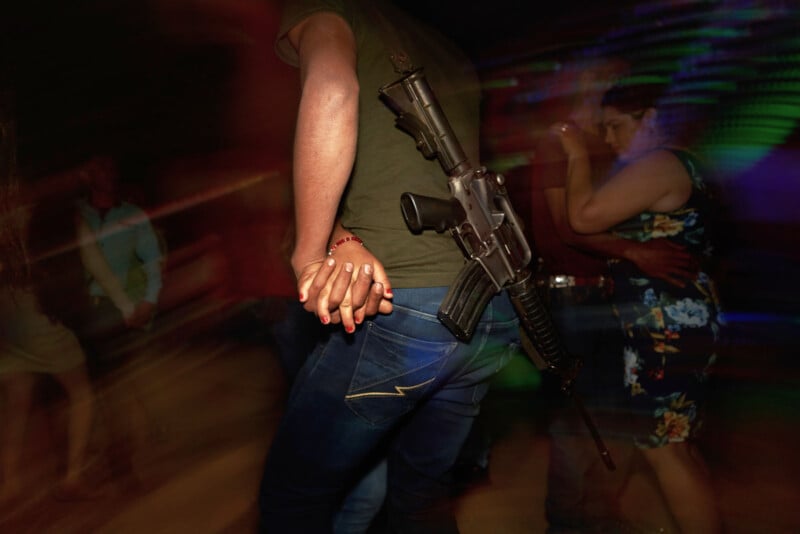A Photojournalist Took a Fujifilm Instax Camera to a Mexican Cartel Wedding
Mexican-born American photojournalist Henry Craver recently traveled to Michoacán, Mexico, a region controlled by organized crime, to document life with his film cameras. However, after running out of film, he boldly took a Fujifilm Instax Mini 12 camera to a wedding and photographed gun-toting cartel members. A bizarre juxtaposition — instant film and organized crime — Craver returned home to New Jersey with spectacular photos and an even more exciting story.
Michoacán, Mexico: A State Run by the Cartel
Craver first traveled to Michoacán in 2020 while reporting on a migration story, and subsequently returned to the state in west-central Mexico multiple times while working on that project. It’s a beautiful, historic part of Mexico, although the region has experienced a surge in violent crime in the 21st century. Criminal groups in Michoacán are routinely better-armed than state security forces, and the U.S. Department of State’s Bureau of Consular Affairs says Americans should not travel to Michoacán “due to crime.”
That didn’t stop Craver, who was born in Mexico to American parents but spent “many of his formative years” in New Jersey.
“I’ve probably been to that part of Michoacán six times now,” Craver tells PetaPixel. “I remember being pretty nervous the first time I went. I had local contacts there from a previous story, but they themselves had been victims of some pretty awful narco-related violence.”
![]()
“That part of Michoacán was also much more volatile five years ago than it is today,” he adds, citing changing power structures among the criminal organizations in the region.
“Back then, a rival group was encroaching in and there were all these stories and signs of frequent fighting. I remember my second trip up there, an important guy’s daughter was getting married, and they had this big wedding at a hacienda off the highway. I’m at my host’s house, maybe a mile away, just hanging out on the porch. All of a sudden, we hear this big blast. A few minutes later, fancy Toyota and Ford pickups are zooming by us up the highway towards the rival group’s territory,” Craver recalls.
“It turned out that the rival cartel had sent guys down on a small motor boat and that they’d flown a drone strapped with explosives from the little boat into the wedding and detonated it. Nobody was killed. As I understand it, though, over the past three years or so, the group that controls this section of Michoacan has really solidified its control, and there’s much less violence.”
With all that experience under his belt and a relatively stable situation in the region these days, Craver says he initially wasn’t concerned about going to a party he knew would be heavily attended by cartel members.
“I’d been to weddings in the area before and thought I knew what to expect: Lots of farmers and a few lower-level mafiosos — they’d all be carrying guns because that’s the culture there, but they’d be happy to chat and be photographed,” Craver says.
![]()
Not Your Typical Wedding Photography Experience
However, despite these reasonable expectations, that was not his experience.
“From the outset of the party, I’m not comfortable,” Craver says.
It turns out that this was not a wedding attended only by low-level cartel members. There were also high-ranking members in attendance who had no interest in being filmed or photographed.
After questioning, Craver was allowed to stay and film, provided he didn’t record any of the higher-ranking gang members. But once everyone mingled and started dancing, he couldn’t tell who had been at the table he was not supposed to photograph.
“It’s not as simple as just avoiding the people with guns, a lot of the men are carrying,” Craver explains.
After settling in, Craver took out his Fujifilm Instax Mini 12 and began photographing the dancers.
![]()
Craver was quickly told to stop in case he accidentally photographed someone who didn’t want to be in any pictures, so he then went to talk to some cartel members off to the side. While that went fine, it did not take long before someone else was upset with Craver’s presence and filming.
“My discomfort obviously gets worse when I get yelled at. And then even after the big mafia figures leave, I think I’m still a little shaken up and struggle to really concentrate on making good photos. Honestly, I felt like I was just kind of shooting to get through the film and feel like I’d done my job,” Craver says.
Defusing Tension With an Instax Camera
However, despite these heightened tensions and a few altercations, the wedding party itself soon invited Craver to take their pictures during the celebrations, highlighting that most people at the party were welcoming and happy to have Craver there taking photos and recording video.
Surprisingly, this experience was Craver’s first time ever using an Instax camera.
“I hadn’t actually planned to do this project with the Instax,” Craver admits. “I’d burned through almost all of my normal 35mm film, making my previous video about the Afro-Mexican communities of the Oaxacan coast, about 13 hours south of this part of Michoacán.”
“So I get to Michoacán and have like half a roll of black-and-white film, my action camera, an Osmo Pocket 3, and this Instax Mini that I picked up weeks before in Mexico City to give to my girlfriend as a Christmas present after the trip,” the photographer tells PetaPixel.
Craver says his “hands were pretty tied when it came to camera choice,” but that the project “worked out okay.”
He says he was worried about busting out a bubbly, round Instax Mini 12 at this party in remote Michoacán, given the camera’s popularity among younger women and girls.
“You look at Instax Mini packaging and marketing, and you see tons of faces, and almost none of them are men. So it’s clearly marketed as a feminine product to a largely feminine audience,” Craver notes. “Rural, gun-toting Michoacanos, by and large, don’t consider themselves feminine. So I was a bit worried that they’d laugh at me, or worse.”

However, as Craver’s video shows, most people were happy to have their pictures taken by an Instax, including many of the gun-toting Michoacanos Craver thought might consider the camera too girly.
“I think lots of people nowadays, across all sorts of demographics, are jaded with digital images and are intrigued by physical prints,” Craver says. He photographed a similar wedding in Michoacán in 2021 using a Sony a7R III, but he doesn’t remember guests being nearly as excited about those photos while Craver was shooting. There’s something special about being able to instantly hold a physical print.

Why Craver Switched From Digital to Become an Analog Photojournalist
While the Instax was used out of necessity, Craver is, at his core, an analog photojournalist. Although Craver had been exclusively shooting digital for six years after becoming passionate about photography in 2018, he moved to film last year, as demonstrated by his string of recent excellent YouTube videos.
“I’d thought about switching to film for a while,” Craver says. “It’s hard not to regurgitate clichés when talking about this… that magic film quality, blah blah blah. But I’d look at photos from the late 20th century, both documentary and editorial, and they just seemed more powerful than similar modern digital images.
“So I concluded [there] was something about film.”
However, Craver believes the only advantage to working with analog is the results. The process itself is challenging, especially as a traveling photojournalist.
“The biggest, and possibly only, advantage to working with analog, in my opinion, is the results. Whatever the image conveys, beauty, sadness, excitement, it’s more intense on film.”
![]()
The drawbacks, as Craver knows firsthand, are much more numerous. Film is expensive, for starters. Further, autofocus on film cameras, like the 90s-era Canon SLRs he uses, is unreliable. While missing a moment is a risk with all types of photography, the risk is heightened with film. Craver is often very far removed from the situation he captured by the time he gets to see his shots.
“The delayed satisfaction can be good sometimes, but that’s more of a mixed bag,” the photographer says.
“However, by far the biggest downside for me is the lack of an LCD,” Craver says. “I never used viewfinders on digital cameras. I always find that I get better results holding the camera away from my best. These film SLRs force me into the viewfinder, and I think it makes my photos stiffer.”
Why Travel Matters
For photographers seeking to follow Craver off the beaten path, whether that is in Mexico or elsewhere, he highly recommends hiring a local journalist or stringer as a guide.
“They’re usually eager for work and have very reasonable rates,” Craver says.
He also recommends focusing on photographing public events, whether that’s local sports or festivals.
“People at events are usually happy to be photographed. The mood is festive, and it’s easy to talk to people,” he says. “I’m partial to rodeos.”
Craver has met many special people through his travels and thanks to photography.
“Photography is a pretext that has taken me to places I’d never have gone otherwise, and it’s been incredibly enriching. I think there’s a lot of value in learning what life is like in different places, and it’s often very fun.”
More From Henry Craver
Henry Craver is an experienced visual journalist actively seeking new opportunities. He and his girlfriend are expecting a child this winter, and Craver, currently unemployed, says “it’s time to get serious.”
“I’m a good storyteller across mediums, a hard worker, and I speak many languages,” Craver says.
People can keep up with Craver’s analog adventures on Instagram, his website, and YouTube. As a note for future readers, Craver is actively working on a new website that will be finished soon.
Image credits: All photos by Henry Craver